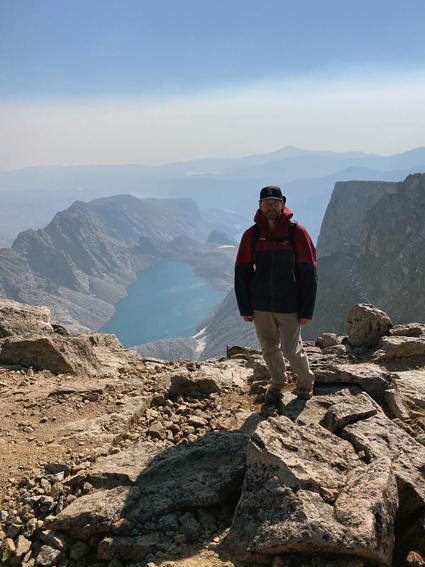6 March 2023–As a non-traditional student, Kevin Ward went back to school “not even clear that I was going back for anything in the geosciences,” he said. “I kind of stumbled upon it when I was taking general ed classes.”
“I was always good at math and physics, but then I also liked the outdoors and hiking and that kind of thing, so it was kind of a natural merging that I wasn’t aware of before college,” said Ward, now an assistant professor of geology and geological engineering at the South Dakota School of Mines and Technology.
He had considered studying particle physics, “but one thing that made that different was that I would never hold that, or never see it. It would always be some sort of version or something on the screen. It’s really neat to think about what things are made of, but I would never see it the same way that I could as if I was on top of a mountain.”
Ward’s broad interests in observational seismology center on imaging of tectonic and magmatic processes in the continental crust and upper mantle. He calls imaging “the hammer” that allows him to get at “the nail” that interests him the most: the complicated tectonics of subduction zones.
He is working with others on a large National Science Foundation-supported project to gain a better understanding of the Cascadia subduction zone. His specific part of the project involves deploying seismic arrays on the land side of the zone to get a better look at what the plate interfaces look like in key areas.
“Cascadia is well-known for being segmented or different along strike, so one thing that we’re hoping to get at is, if we look at two different spots, that have very different either seismicity or topography or uplift,” Ward explained, “if there’s something we can see in our seismic imaging that might explain why we see these differences at the plate interface.”

COVID-19 slowed down some of the work on the project, but last summer he deployed a small subset of instruments in the region to collect passive source seismic data that he and two of his students are beginning to analyze.
Ward is also interested in how data from the proliferation of nodal seismology networks can be compared to data collected from older broadband stations—whether older results can be replicated with nodal data, and how older methodology can be translated to new technologies, he said.
He is an active member of the Subduction Zone 4D (SZ4D) movement, a community-driven initiative to research the multiple components of subduction zones in an integrated fashion. For subduction zones like Cascadia, Ward said, geophysicists, geologists and volcanologists know that they benefit from sharing their findings. “But everyone has been trying to integrate independently,” he said. “Now, to make progress as a community … we’re coming to a consensus that we need to be more integrated from the beginning.”
The overarching goal, he added, “is to produce more societally relevant products as far as forecasting and prediction and modeling for earthquake and volcano hazards.”
The initiative is creating its implementation plan now, but one of the subduction zones planned for study under SZ4D is the Andean subduction zone. Compared to subduction zones in Cascadia and Japan, the Andean zone has been less thoroughly studied, according to Ward, who said a dream deployment would be to “carpet that region, both onshore and offshore, with thousands of seismic instruments.”
In South Dakota, Ward participates in summer camps for high school students exploring the Black Hills, along with speaking at high school career and college recruiting events. It’s become a bigger part of his career than he had ever planned.
“I didn’t know anything about the geosciences when I was at that high school age … so I’m trying to do everything I can to learn where people learn about the geosciences and provide that as an interesting, meaningful and sustainable and also very necessary economic path, a career path, that we need people in this country in moving forward,” he said.
He hopes that some of the students will consider the geosciences at an earlier stage in their careers than he did. “There are these really interesting, satisfying high-paying jobs where you can get out and do some things that a lot of people enjoy to do.”
SSA At Work is a monthly column that follows the careers of SSA members. For the full list of issues, head to our At Work page.
